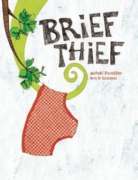
“A lizard takes the liberty of using what seem to be some old underpants when he runs out of toilet paper. What he doesn’t count on is that his own conscience and an outraged rabbit will be watching.”
- ISBN: 9781592701315
- Author: Escoffier, Michael
- Illustrator: Di Giacomo, Kris
- Published: 2013, Enchanted Lion
- Themes: Humor, lizard
- Descriptors: Early Years (ages 2-6), Europe, France, Picture Book, Primary (ages 6-9)
- No. of pages: 32

Jean: There are topics in children’s books such as “..what happens in the bathroom…” to quote a TV ad that are perceived by some as taboo – more so in the United States. European authors seem more willing to take on these indelicate topics than American authors, which bring us to the discussion of this week’s humorous book, Brief Thief by French author Michael Escoffier.
Kathleen: This story is a dialogue between Leon, a lizard, and what he thinks is his conscience. The voice inside his head manipulates or chastises Leon into feeling guilty for taking the underpants hanging in the tree and cleaning himself after he poos. The voice of his conscience convinces Leon that he stole the underpants without thinking about the consequences of his actions.
Jean: It’s a chameleon, not just any old lizard. You can tell it’s a chameleon by his tail and his eyes and his body structure. When I think about chameleons the first thing that pops into my head is their ability to camouflage themselves. They change color to melt into their backgrounds. As a chameleon, Leon thinks this ability makes him invisible; so when he hears the voice of his conscience it is a total surprise to him as to where this invisible voice comes from. In actuality it is the rabbit character that is pretending to be Leon’s the conscience, and we eventually find out the rabbit is the owner of the underpants. It is an interesting link between conscience and camouflage.
Kathleen: The little voice has a whole lot more to say then the chameleon. The text in this story uses color, position, and font to help navigate the reader through the story. For example, the voice of the conscience is in a different font that looks almost handwritten, and gives a somewhat shouting illusion.
Jean: The illustrations do a nice job of reflecting how Leon is feeling throughout the entire book. When the conscience tells him how to fix what he did to the underpants, the illustration depicts a submissive emotion as the chameleon realizes that he had done something wrong by taking underpants that don’t belong to him. Leon has totally given in to his conscience.
Kathleen: I like that you don’t find out the conscience is a rabbit character until the last three pages of the text, and not the “little voice you hear inside your head” as insinuated through the dialogue.
Jean: The last time we see Leon he is a diminishing figure running off in the distance, and the rabbit becomes larger than life taking over as the more important character of this story.
Kathleen: Interestingly enough, the rabbit has most of the dialogue in the book, but in the last two pages where the rabbit is the only character left, there is no text, just the rabbit, putting on his mask (“Old underpants full of holes, indeed!”) and transforming him into a superhero.
Jean: I read this to a group of first graders who really didn’t understand the idea of a conscience out of the blue. If I were to read this to young children again I would probably begin by just asking kids if they can think of a time when they did something they knew they shouldn’t.
Kathleen: Maybe to help young readers with the concept of conscience you could encourage a text-to-text connection by relating Brief Thief to the story Pinocchio highlighting the conscience character, Jiminy Cricket. Well, next week we will look at several text-to-text connections with unusual approaches to voice by the ways books express themselves.